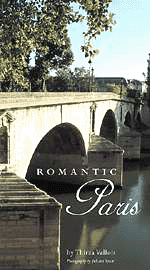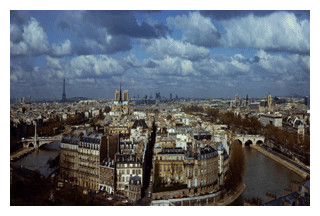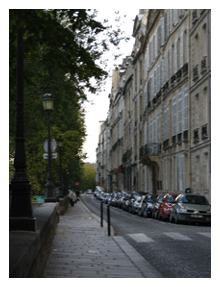Letter from A Parisian Christmas

- SUBSCRIBE
- ALREADY SUBSCRIBED?
BECOME A BONJOUR PARIS MEMBER
Gain full access to our collection of over 5,000 articles and bring the City of Light into your life. Just 60 USD per year.
Find out why you should become a member here.
Sign in
Fill in your credentials below.

Both Around and About Paris and Romantic Paris open to the willing stroller the city’s streets and treasures, where its beauty and soul linger. Of course you will marvel at the dazzling lights along the Champs-Elysées, and whether you have children or not, the Christmas window displays of the grands magasins at the Boulevard Haussmann are a must, matched for some by an ice-skating experience in front of the glamorous Hôtel de Ville. But if you are after a more intimate atmosphere, head for the Ile Saint-Louis: beyond its main street and its lovely boutiques and eating places, discover the architectural splendour along its quais. Provided you are warmly dressed, the old walls are even more moving in winter.
The following is extracted from Around and About Paris, Volume I, a foretaste for your discovery of this unique island:
 The pedestrian bridge will take you to the tiny Ile Saint-Louis, our ultimate destination and Paris at its best: colourful food, shops and eating places, boutiques in impeccable taste, four gem-like hotels, and every a tiny pretty theatre are united into this minuiature world, enhanced by an overall 17th-century architectural unity that would put much of Paris to shame. Occasional scars and eyesores exist here too, but so much of the old heritage has been preserved that they are not obvious to the untrained eye.
The pedestrian bridge will take you to the tiny Ile Saint-Louis, our ultimate destination and Paris at its best: colourful food, shops and eating places, boutiques in impeccable taste, four gem-like hotels, and every a tiny pretty theatre are united into this minuiature world, enhanced by an overall 17th-century architectural unity that would put much of Paris to shame. Occasional scars and eyesores exist here too, but so much of the old heritage has been preserved that they are not obvious to the untrained eye.
In the 17th century the two uninhabited islands were joined into the Ile Saint-Louis and built up. The cannons of Notre-Dame, who hitherto relaxed in the western island, fought off development but were defeated by the urbanisation of Paris, which accelerated during the latter peaceful part of the reign of François I and exploded into fever at the time of Louis XIII and Louis XIV:
Toute une ville entière, avec pompe bâtie
Semble d’un vieux fossé par miracle sortie
The construction on the island was largely undertaken by the most prestigious architects of the day, predominantly by Louis le Vau, to suit the demands of the prominent members of society who settled here. The houses had narrow façades because of shortage of land on the island, but they made up for this by being quite deep, as you can see when occasionally you come upon an unlocked door. The most talented painters decorated these homes, but, unfortunately, little is left of their magnificent work, and what remains is in private hands.
By the end of the 18th century Louis Sébastien Mercier could write:
"The island is a quarter hemmed in by the river and separated from the Cité. It seems to have escaped the great corruption of the town, which has not yet penetrated here. No girl of easy virtue can find lodgnins here: no sooner is she found out than she is expelled. The bourgeois keep an eye on each other […] It has been said accurately: the inhabitant of the Marais is an outsider on the island."
Before walking into quai d’Anjou, note the café/restaurant Au Franc Pinot, on the corner of quai de Bourbon and rue des Deux-Ponts, priding itself on a long history which began in the 17th century, when it catered to passengers arriving by boat from Melun and to boatmen who dropped in for a pint of red wine. Next to it, at no. 3, stood a shop that closed down in 1913. Its beautiful wooden panelling made its way to the Metropolitan Museum in New York, where it serves as a backdrop to the 18th-century French silverware display. Rue des Deux-Ponts runs along the old moat that divided the island in the 13th century. When it was filled up on the 17th century, a narrow street was laid out, lined with elegant houses, but in 1930 it was widened to its present, sorry state, to cope with growing traffic. In the late 1960s two drab blocks of flats added a further eyesore to this former architectural shrine.
 Quai d’Anjou largely makes up for it! The Hôtel de Lauzan at no. 17, with its gilded wrought-iron balcony and fish-scale decorations on the water spouts, is attributed to Louis Le Vau. In the 19th century the mansion was divided up into apartments and often let to artists and bohemians, disrespectful of both premises and neighbours. Charles Baudelaire, Théophile Gautier and other members of the club des Haschichins surrendered here to the artificial paradise of hashish. To one remonstrating neighbour Baudelaire wrote in 1840,
Quai d’Anjou largely makes up for it! The Hôtel de Lauzan at no. 17, with its gilded wrought-iron balcony and fish-scale decorations on the water spouts, is attributed to Louis Le Vau. In the 19th century the mansion was divided up into apartments and often let to artists and bohemians, disrespectful of both premises and neighbours. Charles Baudelaire, Théophile Gautier and other members of the club des Haschichins surrendered here to the artificial paradise of hashish. To one remonstrating neighbour Baudelaire wrote in 1840,
"Sir, I chop up wood in my living room, I drag my mistress about by her hair; this is done in everybody’s home and you have no right to interfere."
Baudelaire will be forgiven for this anti-social behaviour, for which he largely made up by writing here the first poems of Les Fleurs du mal. In 1928 the City of Paris purchased the mansion, thereby saving it from demolition. You will only have the privilege of seeing the interior—truly a masterpiece—on a guided tour, unless you are a glamorous VIP and may then be hosted here on an occasion of an official visit.

For further information as to where to stay, eat, shop and be entertained on the Ile Saint-Louis, look up Romantic Paris, by Thirza Vallois, published by Arris Books.


